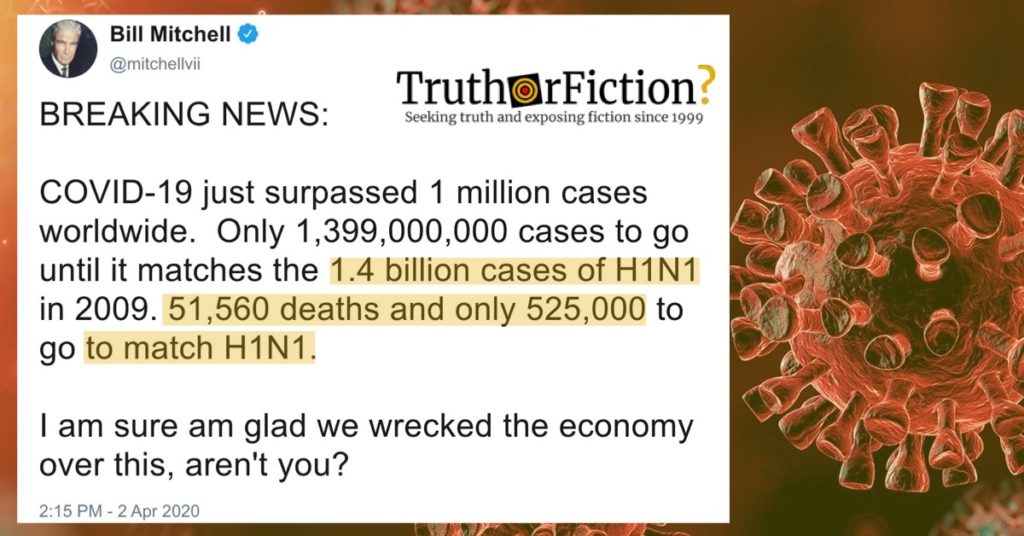Under “tweets that didn’t age well,” on April 2 2020 pundit Bill Mitchell criticized measures to stop the spread of COVID-19 — claiming that the 2009 H1N1 (swine flu) pandemic infected 1.4 billion people worldwide and killed almost 600,000:
Mitchell tacked on a claim that “we wrecked the economy” over COVID-19, implying that economic downturns were avoidable without social distancing — which is an opinion that is not necessarily grounded in any facts.
The Tweet
He said:
BREAKING NEWS:
COVID-19 just surpassed 1 million cases worldwide. Only 1,399,000,000 cases to go until it matches the 1.4 billion cases of H1N1 in 2009. 51,560 deaths and only 525,000 to go to match H1N1.
I am sure am glad we wrecked the economy over this, aren’t you?
According to Mitchell, a total 1.4 billion people were infected during the H1N1 pandemic, and 576,560 (525,000 + 51,560) people died globally during the swine flu pandemic.
Actual Numbers
Mitchell didn’t provide a citation for his sources in the April 2 2020 tweet above, but the 1.4 billion statistic (and a similar mortality figure) appeared in a March 18 2020 LiveScience article:
It’s been a little over a decade since the world experienced its last pandemic, the 2009 H1N1 swine flu. Between the spring of 2009 and the spring of 2010, the virus infected as many as 1.4 billion people across the globe and killed between 151,700 and 575,400 people, according to the Centers for Disease Protection and Control. Now, the world is in the midst of the COVID-19 pandemic, caused by a novel coronavirus called SARS-CoV-2.
The context of that reporting was relevant. Although Mitchell claimed that there were “1.4 billion cases of H1N1 in 2009” and just under 600,000 deaths, LiveScience included ranges for both:
- “… as many as 1.4 billion” infected;
- “… between 151,700 and 575,400” deaths.
Reference to “as many as” and “between” alluded to a range of estimates, and Mitchell sifted out the absolute highest numbers to attempt to make his point.
But even that short excerpt contained additional context — namely, that those figures were compiled well after the H1N1 pandemic had ended. Comparing rates of infections and deaths at the beginning of a pandemic versus years after one ends is obviously going to yield misleading and unsteady comparisons, since as of April 2 2020, a large number of people had yet to fall ill with or die from COVID-19.
LiveScience.com cited the Centers for Disease Control and Prevention for its statistic, and linked to this page (“2009 H1N1 Pandemic.”) The number 1.4 billion does not appear anywhere on that page, and the statistic appears to have been extrapolated from either this portion:
Though the 2009 flu pandemic primarily affected children and young and middle-aged adults, the impact of the (H1N1)pdm09 virus on the global population during the first year was less severe than that of previous pandemics. Estimates of pandemic influenza mortality ranged from 0.03 percent of the world’s population during the 1968 H3N2 pandemic to 1 percent to 3 percent of the world’s population during the 1918 H1N1 pandemic. It is estimated that 0.001 percent to 0.007 percent of the world’s population died of respiratory complications associated with (H1N1)pdm09 virus infection during the first 12 months the virus circulated.
Or from 2013 estimates that one in five people globally had contracted H1N1 in 2009 and 2010:
The study, which used data from 19 countries, collated results from more than 24 studies involving some 90,000 blood samples collected before, during and after the pandemic. The results, published in the journal Influenza and Other Respiratory Viruses, showed 20 to 27 percent of people studied were infected during the first year of the pandemic.
Once again, those figures were the high end of a range, and estimated.
Interim COVID-19 Infections and Deaths
Incidentally, 22 days after Mitchell’s tweet, on April 24 2020, nearly 200,000 people worldwide had died of COVID-19 (and more than 50 thousand of those deaths were in the United States):
Cherry picking in the same fashion Mitchell did could, for instance, support the argument that as of April 24 2020, more people died of COVID-19 early in the pandemic than had died in the lower range of estimates for the totality of the H1N1/swine flu pandemic (151,700).
Pandemics and Wide Estimated Ranges
On April 23 2020, we examined a different pandemic comparison on Twitter, and noted that even the modern attempts to piece together exact figures were inexact:
Figures on the high ended tended to included guesses or estimates about those mildly sickened or otherwise not counted officially, and researchers created such tallies in a variety of ways in order to better quantify the long-term effects of pandemics. Although research and medical study have advanced by leaps and bounds since the 1918 Spanish flu pandemic, limitations in counting unreported cases continued to clearly hinder researchers’ ability to hammer down extremely precise numbers — leaving ranges as wide as between “151,700 and 575,400” deaths during a 2009-2010 pandemic.
In Summation
Mitchell claimed that 1.4 billion people were infected during the 2009-2010 H1N1 (swine flu) pandemic, and over 575,000 people died. Mitchell seemed to deliberately select the absolute highest end of very wide ranges, figures assessed years after that pandemic had come and gone. Mitchell’s tweet also appeared at the beginning of the novel coronavirus or COVID-19 pandemic, and within a few weeks, there had been more deaths globally (194,000) than the lowest range for the totality of the H1N1 pandemic (157,000). In short, not only was the premise flawed and dishonestly presented, but the claims were Not True.

